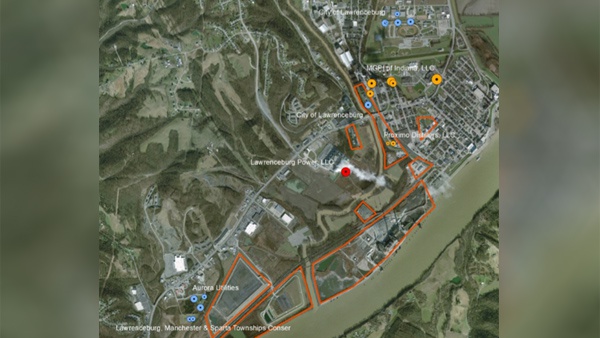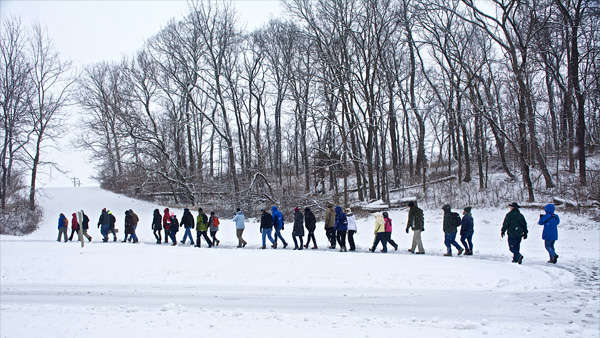The new study focuses on Lawrenceburg Municipal Utilities' public drinking water wells, but provides little insight for wells belonging to Aurora Utilities and Lawrenceburg-Manchester-Sparta Conservancy District.

A map from the Intera report for Lawrenceburg Municipal Utilities. Mapped coal ash sites are outlined in orange. Blue dots are public water supply wells, orange dots are industrial wells, and the red dot is an energy production well. Image via Intera report "Evaluation of Well Field Risks Related to Coal Ash Storage."
(Lawrenceburg, Ind.) - A geoscientist claims that the City of Lawrenceburg’s underground water supply is not under threat from fly ash ponds at the former Tanners Creek Power Plant site.
However, questions remain about how other area water utilities might be impacted by potential contamination of the aquifer.
Intera Geoscience & Engineering Solutions was “vetted and hired” by Lawrenceburg Municipal Utilities, according to LMU director Olin Clawson. The company was asked to study the risk of groundwater contamination posed by the toxic fly ash.
Dr. Jack Whittman, Intera vice president and principal geoscientist based in the company’s Bloomington, Indiana office, presented the company’s findings to the Lawrenceburg Utility Service Board on Monday. He said he has been studying water issues in Indiana for 25 years.
“The questions I looked at that I think are the most critical are where is the groundwater that is going into the wells moving from, and is there a risk to those wells from contamination,” Whittman told the board.
Testing of local water does not indicate any contaminant of any kind reaching the wells right now, he said.
“We are talking about numbers that are all below World Health Organization standards and very low levels. As far as I can see, there is no problem,” said Whittman.
|
Main findings and recommendation from the Intera report: • Based on the water quality data from the wells in the area and the modeling used to reflect the hydraulics of the stream-aquifer interaction along the River near Lawrenceburg, there is no indication of any risk or water quality concern in public drinking water. In addition, another long-term safety factor for LMU wells is the industrial pumping in the Lawrenceburg aquifer that creates a hydraulic barrier to potential contamination from the South. • Concerns about the proximity of the coal ash do not account for the water budget of the system. Only a small fraction of the water pumped by the wells has made contact with the ash. Most of the water pumped by all of these wells is simply groundwater that has moved slowly through the aquifer below the surface storage piles of ash into the wells. • While water quality is currently good, it is generally good practice to manage an aquifer of this importance collaboratively among the water users. For example, groundwater monitoring could be coordinated – water levels and groundwater quality samples could be taken regularly in all wells. A monitoring plan could be developed for this effort. Source: Intera Geoscience & Engineering Solutions |
Whittman determined Lawrenceburg’s water quality is good and is not at risk because groundwater flows to the city’s drinking water wells mainly from the north. Based on 2017 pumping estimates of wells for public water, industrial use and the Lightstone Generation natural gas power plant, there is not enough recharge of the aquifer to satisfy the usage.
“Some of the water does come from the river to satisfy the well field,” he explained.
An industrial well used by the MGPI of Indiana distillery in Lawrenceburg and Greendale creates a divide between the ash ponds and most of LMU’s wells. The distillery pumps around six million gallons of water from that well each day, according to the report.
Findings of the Intera study, Whittman said, are similar to those in the City of Lawrenceburg’s wellhead protection plan approved by the Indiana Department of Environmental Management in 2008. The person who prepared the protection plan, James Carr of Hydrophase, Inc., was in attendance at Monday’s meeting.
Whittman said it is important to understand the depth of the wells and how the water table flows at differing depths. He also urged local utilities to work with other state and local agencies to consider how any new wells or reduced usage may impact the aquifer.
The utility board members, who are all members of Lawrenceburg Common Council, voted unanimously to share the Intera study with the public. You can view the full Intera report to LMU here (PDF).
Clawson called the new study a starting point.
“We’re hoping to continue the relationship and continue to monitor and track what’s happening in the wells and our well fields from now on. It is something I can’t stress enough how much we’re concerned about that. It’s taken us a while to get to this point, but here we are,” said Clawson.
The Intera study, however, does not answer the question of whether water wells for Aurora Utilities and Lawrenceburg-Manchester-Sparta Conservancy District are at risk. Those wells are located closer to and just west of one of the former power plant site’s largest ash ponds. Other studies of how water moves through the aquifer determined that the aquifer moves beneath the ash ponds in the direction of those wells.
Both lined and unlined ash storage areas at Tanners Creek are already sitting within part of the aquifer, which is only several feet below the ground surface. Last fall, Indiana Department of Environmental Management inspectors observed large areas of fly ash deposited in unpermitted areas at the power plant property.
Environmental groups including the Hoosier Environmental Council, Lower Ohio River Waterkeeper, Hoosier Chapter of the Sierra Club, and Citizens Action Coalition have written to IDEM about the threat to groundwater posed by the ash ponds in Lawrenceburg.
At a January town hall meeting at the Lawrenceburg Public Library, Hoosier Environmental Council senior policy director Tim Maloney said the fly ash impoundments are doing damage to the groundwater.
“Covering an unlined surface lagoon does not stop contamination from happening underneath,” Maloney said at the town hall. “The concept of closing in place is fraught with so many problems.”
IDEM is currently considering property owner Tanners Creek Development LLC’s revised closure plans for the Lawrenceburg ash ponds.
As the Intera study determined, Maloney said there has not been any evidence that local drinking water supplies are currently exceeding contamination standards. In order to reduce the risk of contamination in the future, the Hoosier Environmental Council is advocating that the millions of tons of fly ash at Tanners Creek be excavated and relocated.
RELATED STORIES:
Hoosier Environmental Council Updates Citizens On Findings At Tanners Creek, And It Isn't Good
IDEM Finds Large Amounts Of Fly Ash In Unpermitted Areas Of Tanners Creek Plant Site
Ports Of Indiana, Tanners Creek Development Extend Purchase Agreement
IDEM: Lawrenceburg Ash Pond Closure Plan On Hold As Federal Cases Linger
Public Hearing For Tanners Creek Ash Pond Closure Plan Could Happen Oct. 11
Environmental Groups Urge IDEM To Deny Revised Fly Ash Pond Closure Plan
Tanners Creek Development, IDEM Answer Citizens On Fly Ash, Groundwater
After Out-Of-State Fly Ash Halted, Questions Over What's Already In The Ground At Tanners Creek

 Legislators to Discuss Rising Star Casino Relocation
Legislators to Discuss Rising Star Casino Relocation
 2025 Rewind: Year in Review
2025 Rewind: Year in Review
 Great Parks' Winter Hike Series Returns in New Year
Great Parks' Winter Hike Series Returns in New Year
 Rising Sun Basketball Volunteers at YES Home
Rising Sun Basketball Volunteers at YES Home
 Sisters of St. Francis to Celebrate 175th Anniversary
Sisters of St. Francis to Celebrate 175th Anniversary
 Lawrenceburg Public Library Announces Upgrades Coming in 2026
Lawrenceburg Public Library Announces Upgrades Coming in 2026













